Sherlock Jr
8.8 /10 1 Votes8.8
94% Rotten Tomatoes Genre Comedy, Family, Fantasy | 8.3/10 IMDb Duration Country United States | |||||||||||||||||||||||||||||||||
 | ||||||||||||||||||||||||||||||||||
Release date April 21, 1924 (1924-04-21) Music director Club Foot Orchestra, Beth Custer, Myles Boisen, Steve Kirk, Nik Phelps, Sheldon Brown Cast (Sherlock, Jr.), (Girl), (Girl's Father), Erwin Connelly (The Butler), (Sheik), Doris Deane (Girl Who Loses Dollar Outside Cinema (uncredited))Similar movies Unusual Cooking , How Foolshead Paid His Debts , Salt , Bluebeard , The Witch and the Bicyclist , Uncle Josh's Nightmare | ||||||||||||||||||||||||||||||||||
Sherlock jr 1924 full good music
Sherlock Jr. is a 1924 American silent comedy film directed by and starring Buster Keaton and written by Clyde Bruckman, Jean Havez and Joseph A. Mitchell. It features Kathryn McGuire, Joe Keaton and Ward Crane.
Contents
- Sherlock jr 1924 full good music
- Buster keaton sherlock jr making of
- Plot
- Cast
- Production
- Release and critical response
- Legacy
- Accolades
- References

In 1991, Sherlock Jr. was selected for preservation in the United States National Film Registry by the Library of Congress as being "culturally, historically, or aesthetically significant." In 2000, the American Film Institute, as part of its AFI 100 Years... series, ranked the film #62 in its list of the funniest films of all time (AFI's 100 Years... 100 Laughs).
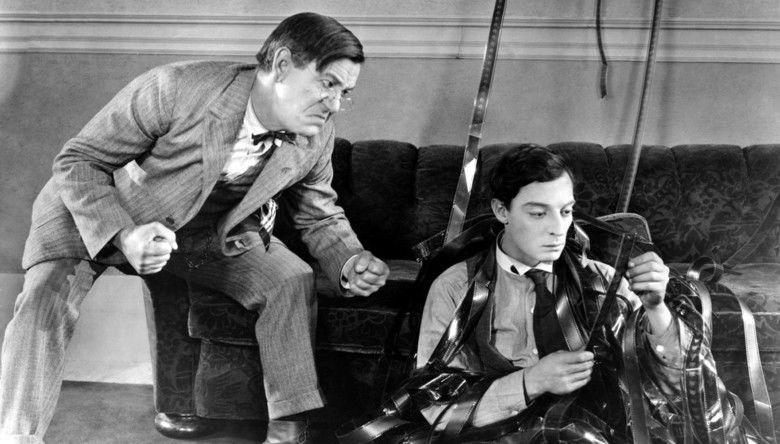
Buster keaton sherlock jr making of
Plot
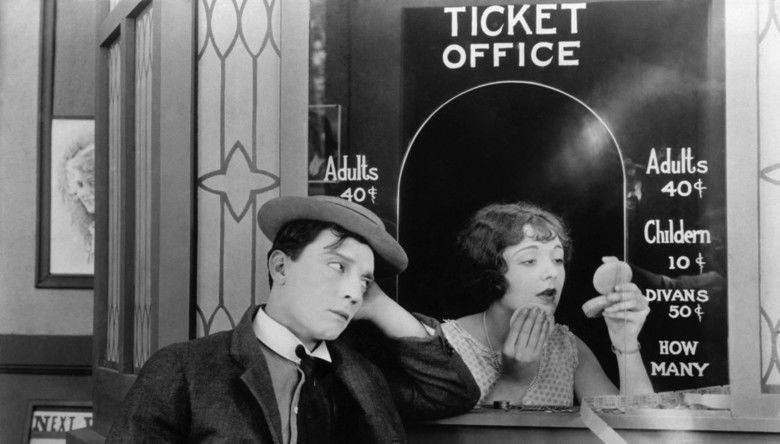
A movie theater projectionist and janitor (Buster Keaton) is in love with a beautiful girl (Kathryn McGuire). However, he has a rival, the "local sheik" (Ward Crane). Neither has much money. The projectionist buys a $1 box of chocolates, all he can afford, and changes the price to $4 before giving it and a ring to her. The sheik steals and pawns the girl's father's pocket watch for $4. With the money, he buys a $3 box of chocolates for the girl. When the father notices his watch is missing, the sheik slips the pawn ticket into the projectionist's pocket unnoticed. The projectionist, studying to be a detective, offers to solve the crime, but when the pawn ticket is found in his pocket, he is banished from the girl's home.

While showing a film about the theft of a pearl necklace, the projectionist falls asleep and dreams that he enters the movie as a detective, Sherlock Jr. The other actors are replaced by the projectionist's "real" acquaintances. The dream begins with the theft being committed by the villain (played by the local sheik) with the aid of the butler (played by the hired man). The girl's father calls for the world's greatest detective, and Sherlock Jr. arrives. Fearing that they will be caught, the villain and the butler attempt to kill Sherlock through several traps, poison, and an elaborate pool game with an exploding 13 ball. When these fail, the villain and butler try to escape. Sherlock Jr. tracks them down to a warehouse but is outnumbered by the gang that the villain was selling the necklace to. During the confrontation, Sherlock discovers that they have kidnapped the girl. With the help of his assistant, Gillette, Sherlock Jr. manages to escape this situation, save the girl, and defeat the gang.
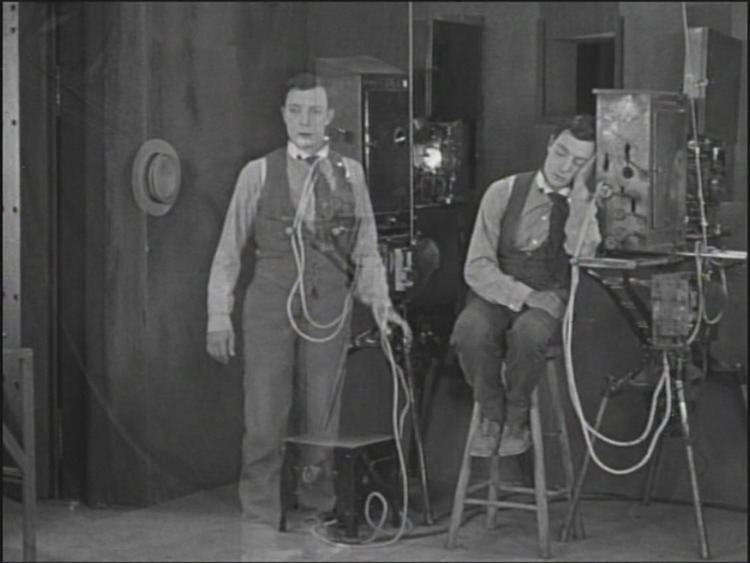
When he awakens, the girl shows up to tell him that she and her father learned the identity of the real thief after she went to the pawn shop to see who actually pawned the pocket watch. As a reconciliation scene happens to be playing on the screen, the projectionist mimics the actor's romantic behavior.
Cast
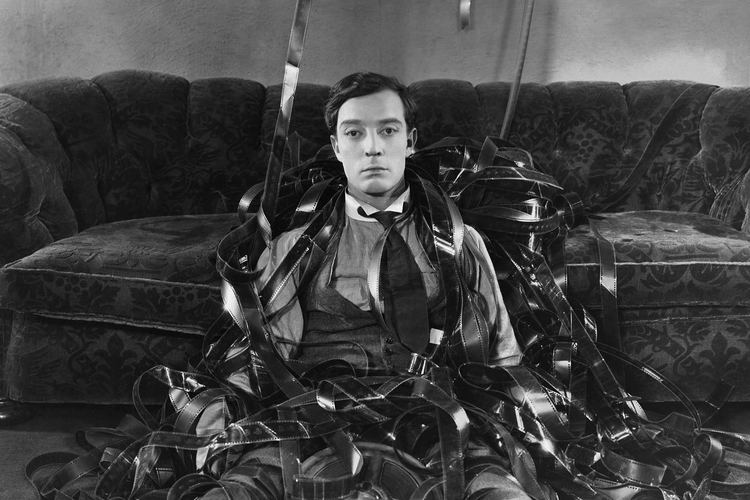
Production
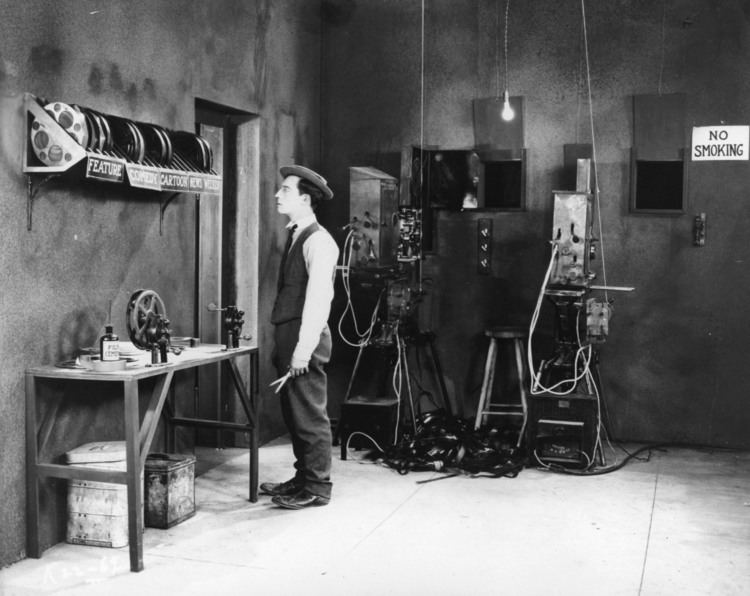
Originally titled The Misfit, production began in January 1924 in Los Angeles. Keaton later said that his character walking onto the screen and into a film was "the reason for making the whole picture...Just that one situation." After previously casting her in Three Ages, Keaton cast Marion Harlan as the lead actress, but she became sick and was replaced by up-and-coming Keystone Studios actress Kathryn McGuire, who had previously starred in The Silent Call and was a Wampas Baby Star of 1923.
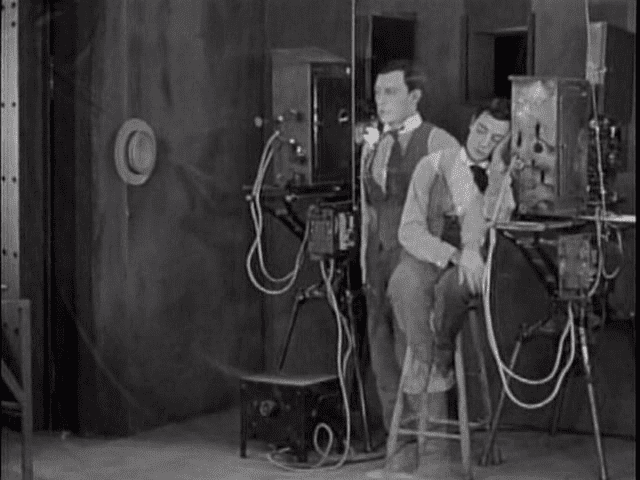
Keaton initially hired Roscoe "Fatty" Arbuckle as his co-director for the film. Arbuckle had discovered Keaton and his career was at a standstill after being falsely accused of raping Virginia Rappe in 1921. During the scandal and court case, Arbuckle had lost his mansion and cars and was in debt for $750,000. Keaton wanted to help his old friends career and financial problems and hired Arbuckle under the pseudonym "William Goodrich". Filming began well and Arbuckle was happy to be back on set, but after Keaton corrected a mistake that Arbuckle made his attitude changed dramatically. Arbuckle became angry and abusive on set, yelling at actors and according to Keaton becoming "flushed and mad...[the scandal] just changed his disposition." In his autobiography Keaton claimed that Arbuckle was difficult to work with and he arranged for him to direct The Red Mill instead so that Keaton could complete the film alone. The Red Mill didn't begin production until 1927. Arbuckle's second wife Doris Deane later claimed that Arbuckle had directed the entire film and had come up with all of the ideas for the film.
The production included one of Keaton's most famous on-set accidents. In a scene where Keaton grabs a water spout while walking on a moving boxcar train, the water unexpectedly flooded down on Keaton much harder than anticipated, throwing him to the ground. The back of Keaton's neck slammed against a steel rail on the ground and caused him to black out. The pain was so intense that Keaton had to stop shooting later that day and he had "blinding headaches" for weeks afterwards, but continued working due to his well-known high threshold for physical pain. It was not until 1935 that a doctor spotted a callus over a fracture in Keaton's top vertebra in an X-ray. The doctor informed Keaton that he had broken his neck during the accident nine years earlier and not realized it. Keaton famously always performed his own stunts, and this was not the only accident on set. In another scene Keaton was in a motorcycle accident when the bike he was riding skidded and smashed into two cameras, knocking over Eddie Cline and throwing Keaton onto a nearby car.
Sherlock Jr. was also Keaton's most complicated film for special optical effects and in-camera tricks. The film's most famous trick shot involves Keaton jumping into a small suitcase and disappearing. Keaton later said that it was an old vaudeville trick that his father had invented and he later performed it on the Ed Sullivan Show in 1957, but never publicly revealed how he did it. The trick was accomplished with a trap door behind the suitcase and an actor lying horizontally with long clothes hiding his absent bottom torso, which then allowed the actor to smoothly fall forward and walk as though he had always be standing vertically. Keaton later said that they "spent an awful lot of time getting those scenes." Filming took four months, while typically it took Keaton two months to finish a feature film. The editing was also difficult and took longer than a typical Keaton film. Keaton later told film historian Kevin Brownlow "every cameraman in the business went to see that picture more than once trying to figure out how the hell we did some of that."
Keaton depicted an early example of a film within a film in the dream scene, which consists of the main character, Sherlock, entering the world of the parlor mystery-film he is watching. Sherlock is transported to a total of seven different scenes. This was unique at the time because there was a continuity to the scenes and this strategy had rarely been used by film makers. Keaton and his camera man were able to do this by using surveyor's instruments to position Keaton and the camera at exactly the right distances and positions to provide the illusion of continuity.
Release and critical response
Keaton first previewed the film in Long Beach, California. Although audience members gasped at some of the special effects, there were very few laughs, and Keaton began re-editing the film to make it funnier. However, the second preview screening was more disappointing than the first, and Keaton continued cutting the film down to a very short 5-reel film. Producer Joseph Schenck wanted Keaton to add another 1,000 feet of film (approximately 11 minutes), but Keaton refused. The film was retitled Sherlock Jr. and released on April 21, 1924. It made $448,337, slightly less than Three Ages. Keaton considered the film "alright [but] not one of the big ones", possibly due to the fact that it was his first real failure after a then 25-year career on stage and screen.
Adding to the film's mediocre box office, Sherlock Jr. received mixed critical reviews. It received good reviews from The New York Times, which called it "one of the best screen tricks ever incorporated in a comedy", and Photoplay, which called it "rare and refreshing." Other positive notices came from The Los Angeles Times, The Washington Post and The Atlanta Constitution. Negative reviews included Picture Play, which said it was devoid of "ingenuity and originality." Variety said it was as funny as "a hospital operating room." Edmund Wilson of The New Republic criticized Keaton's performance for not having enough character development and the film for having too much "machinery and stunts."
Legacy
Recently, Time magazine named Sherlock Jr. as one of the All-Time 100 Movies. They wrote, "The impeccable comedian directs himself in an impeccable silent comedy...Is this, as some critics have argued, an example of primitive American surrealism? Sure. But let's not get fancy about it. It is more significantly, a great example of American minimalism—simple objects and movement manipulated in casually complex ways to generate a steadily rising gale of laughter. The whole thing is only 45 minutes long, not a second of which is wasted. In an age when most comedies are all windup and no punch, this is the most treasurable of virtues."
Film critic Dennis Schwartz wrote, "[The film is] one of Buster's superior silent comedies that's noted for his usual deadpan humor, frolicsome slapstick, the number of very funny sight gags, the many innovative technical accomplishments and that he did his own stunts (including the dangerous one where he was hanging off a ladder connected to a huge water basin as the water poured out and washed him onto the railroad track, fracturing his neck nearly to the point of breaking it. Keaton suffered from severe migraines for years after making this movie)."
The review aggregator Rotten Tomatoes reports 94% approval from 17 critics, with an average rating of 9.7/10.
In 2012, it was ranked number 61 in a list of the best-edited films of all time as selected by the members of the Motion Picture Editors Guild. It was a major influence in Woody Allen's 1985 film The Purple Rose of Cairo.
Accolades
In 1991, Sherlock Jr. was selected for preservation in the United States National Film Registry by the Library of Congress as being "culturally, historically, or aesthetically significant."
The film is recognized by American Film Institute in these lists:
References
Sherlock Jr. WikipediaSherlock, Jr. IMDbSherlock, Jr. Rotten TomatoesSherlock Jr themoviedb.org
